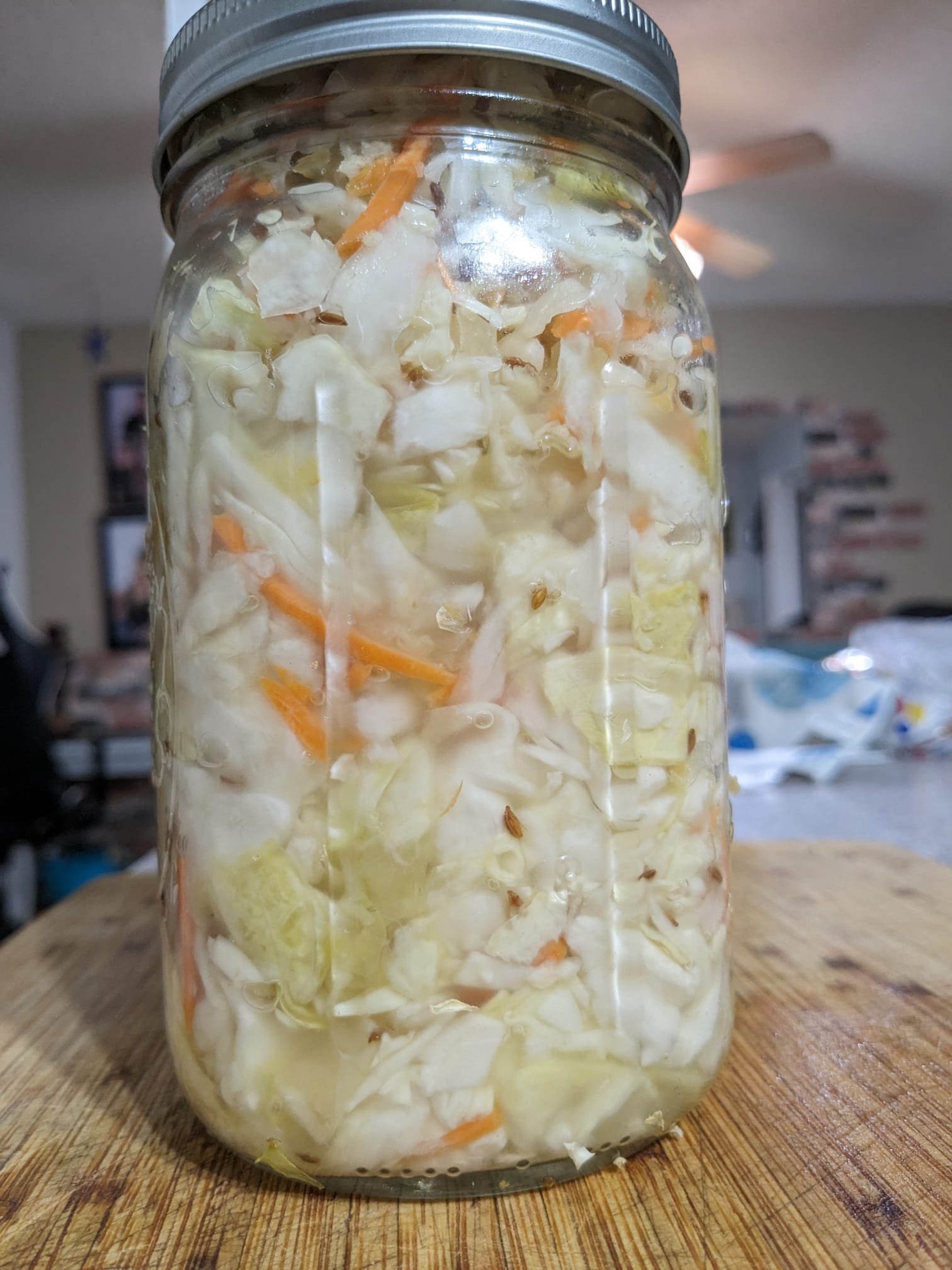In the heart of German cuisine lies a humble yet iconic dish that has earned its place on tables around the world – sauerkraut. This fermented cabbage creation is more than just a side; it’s a symbol of Germany’s rich culinary heritage. Rooted in centuries of tradition, sauerkraut embodies the essence of preserving and enhancing the flavors of seasonal produce.
From Field to Fermentation Jar
The process of crafting sauerkraut is a testament to the resourcefulness and culinary ingenuity of the German people. Starting with fresh, crisp cabbage, the leaves are finely shredded and combined with salt. This simple yet precise act initiates the fermentation journey. As the cabbage rests in its briny environment, beneficial bacteria naturally present on the cabbage leaves begin their transformative work. Over time, these microbes convert the natural sugars in the cabbage into lactic acid, giving sauerkraut its distinctive tangy flavor.
Culinary Versatility
Sauerkraut’s versatility is a key factor in its enduring popularity. It can be enjoyed in various forms and incorporated into a wide array of dishes. From being paired with succulent bratwurst sausages to adding a zesty kick to hearty stews and sandwiches, sauerkraut’s ability to elevate a dish is unmatched. Its bold, sour flavor profile complements rich meats, balances savory flavors, and offers a unique textural element to culinary creations.
A Tradition Rooted in Necessity
The origins of sauerkraut are steeped in practicality and necessity. Historically, fermentation was a vital method of preserving vegetables for the long winter months. Cabbage, readily available in the late harvest season, proved to be an excellent candidate for this preservation technique. The resulting sauerkraut not only provided sustenance during lean times but also delivered a burst of much-needed nutrients.
A Global Culinary Ambassador
While sauerkraut is undeniably a cornerstone of German cuisine, its influence has transcended borders. This tangy delight has found its way into kitchens worldwide, adapting and integrating into diverse culinary traditions. From Eastern European specialties to fusion dishes in contemporary cuisine, sauerkraut’s global journey is a testament to its enduring appeal.
Preserving Tradition, One Jar at a Time
In today’s fast-paced culinary landscape, where convenience often trumps tradition, sauerkraut stands as a reminder of the art of preserving flavors through time-honored methods. Whether enjoyed as a condiment, a side dish, or a central component of a culinary masterpiece, sauerkraut remains a beloved staple that bridges generations.

Today, I am excited to share with you a cherished recipe that I learned from my mother-in-law. It’s a recipe that’s not only delicious but also a testament to the importance of using the right ingredients and techniques. At the heart of this culinary adventure is the magical Ukrainian rock salt, a key element that ensures your cabbage will transform into delectable sauerkraut. Let’s dive into the art of making sauerkraut, step by step.
The Essentials: Ukrainian Rock Salt. First and foremost, let’s talk about the star ingredient: Ukrainian rock salt. I use Ukrainian rock salt, but I am sure you can use other type of rock salt. This is a crucial component of the sauerkraut-making process. It’s important to note that we’re using rock salt, not iodized or table salt. Rock salt’s unique properties play a vital role in the fermentation process and preserving the cabbage.
Ingredients You’ll Need: One head of cabbage, Ukrainian rock salt (approximately 1 1/2 tablespoons), Sliced carrots, One thinly sliced apple, Caraway seeds, Fresh or frozen cranberries
The Process: Begin by thinly slicing the cabbage. It’s a good idea to wear rubber gloves during this step to protect your hands. Add the sliced carrots, thinly sliced apple, a sprinkle of caraway seeds, and a handful of fresh or frozen cranberries to the sliced cabbage. Now, it’s time to incorporate the Ukrainian rock salt. Use approximately 1 1/2 tablespoons of this special salt. Massage the mixture thoroughly until you start to see water and wetness appear. Prepare a glass jar for your sauerkraut. To kickstart the fermentation process, place one slice of rye bread with honey at the bottom of the jar. Start loading the cabbage and carrot mixture into the jar. As you add it, use a wooden or plastic object to compact the mixture. You want the water from the cabbage to seep through. If, by the time you’ve filled the jar, there isn’t enough water to submerge the mixture, you can create a filtered water mixture. Use one tablespoon of rock salt for every liter of water. Pour this mixture on top until the liquid covers the kraut. To ensure proper fermentation, place a solid cabbage leaf on top and weigh it down. You can use a water-filled glass jar or a sanitary weight like a clean, unwrapped can. This will help maintain the pressure required for fermentation. Cover the jar with a cheese cloth to allow air circulation while keeping out contaminants.
Now comes the waiting game. You’ll need to wait for 3 to 4 days before your homemade sauerkraut is ready to enjoy.
Perfecting Your Sauerkraut: During final Steps, as your sauerkraut undergoes its three-day fermentation journey, there are a couple of crucial steps to take to ensure that it turns out just right. Here’s what you’ll need to do during this waiting period:
1. Releasing Air and Encouraging Fermentation: Gently uncover your kraut and carefully poke it with a wooden stick. You’ll notice a fascinating phenomenon: bubbles will start to emerge, and there will be a surge of liquid. This is a good sign! It means that the fermentation process is well underway. As you poke, you’ll be releasing trapped gas, and the liquid will seep inside, enriching the flavors of your sauerkraut.
2. Finalizing the Fermentation Process: After three or four days, it’s time to halt the fermentation process. This is when you’ll want to transfer your sauerkraut into jars for storage.
3. Storing Your Sauerkraut: Place your sauerkraut-filled jars in the fridge. This step not only halts the fermentation but also keeps your sauerkraut fresh and ready to enjoy whenever you please.
Voilà, You’re Done!
And there you have it! With a little patience and a lot of love, you’ve successfully created a batch of homemade sauerkraut. The Ukrainian rock salt, combined with the precise fermentation process, has transformed simple ingredients into a flavorful delicacy. Now, every time you open that jar and savor the tangy, crunchy goodness, you’ll know you’ve mastered the art of sauerkraut-making. Enjoy!
As you embark on this sauerkraut-making journey, you’re not just creating a delicious dish; you’re preserving a tradition that has been passed down through generations. The rock salt is the secret ingredient that unlocks the flavors and transforms a simple cabbage into a culinary masterpiece. So, roll up your sleeves, embrace tradition, and savor the results of your sauerkraut-making adventure. As you savor the tangy goodness of sauerkraut, you’re not just indulging in a dish; you’re partaking in a rich tapestry of history, culture, and the culinary prowess of the German people. So, the next time you encounter this fermented gem, take a moment to appreciate the tradition that lies within each tangy bite. Prost!






